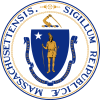This article needs additional citations for verification .(November 2024) |
| Elections in Massachusetts |
|---|
 |
Massachusetts elected its members November 3, 1806.
Contents
| District | Incumbent | Party | First elected | Result | Candidates [lower-alpha 1] |
|---|---|---|---|---|---|
| Massachusetts 1 "Suffolk district" | Josiah Quincy | Federalist | 1804 | Incumbent re-elected. | √ Josiah Quincy (Federalist) 57.7% [1] James Prince (Democratic-Republican) 42.2% |
| Massachusetts 2 "Essex South district" | Jacob Crowninshield | Democratic-Republican | 1803 | Incumbent re-elected. | √ Jacob Crowninshield (Democratic-Republican) 54.8% Samuel Putnam (Federalist) 45.0% |
| Massachusetts 3 "Essex North district" | Jeremiah Nelson | Federalist | 1804 | Incumbent retired. New member elected. Federalist hold. | √ Edward St. Loe Livermore (Federalist) 67.6% Thomas Kitteridge (Democratic-Republican) 32.4% |
| Massachusetts 4 "Middlesex district" | Joseph Bradley Varnum | Democratic-Republican | 1794 | Incumbent re-elected. | √ Joseph Bradley Varnum (Democratic-Republican) 74.0% Ebenezer Bridgely (Federalist) 25.1% |
| Massachusetts 5 "Hampshire South district" | William Ely | Federalist | 1804 | Incumbent re-elected. | √ William Ely (Federalist) 57.1% Samuel Fowler (Democratic-Republican) 38.5% William Eaton (Federalist) 4.4% |
| Massachusetts 6 "Hampshire North district" | Samuel Taggart | Federalist | 1803 | Incumbent re-elected. | √ Samuel Taggart (Federalist) 64.4% Solomon Snead (Democratic-Republican) 35.6% |
| Massachusetts 7 "Plymouth district" | Joseph Barker | Democratic-Republican | 1804 | Incumbent re-elected. | √ Joseph Barker (Democratic-Republican) 60.8% Nahum Mitchell (Federalist) 38.4% |
| Massachusetts 8 "Barnstable district" | Isaiah L. Green | Democratic-Republican | 1804 | Incumbent re-elected. | √ Isaiah L. Green (Democratic-Republican) 63.4% Wendall Davis (Federalist) 34.6% Others 2.0% |
| Massachusetts 9 "Bristol district" | Phanuel Bishop | Democratic-Republican | 1798 | Incumbent retired. New member elected. Democratic-Republican hold. | √ Josiah Dean (Democratic-Republican) 55.1% Nicholas Tillinghast (Federalist) 43.1% Nathaniel Morton 1.6% |
| Massachusetts 10 "Worcester South district" | Seth Hastings | Federalist | 1800 (Special) | Incumbent retired. New member elected. Federalist hold. | √ Jabez Upham (Federalist) 53.9% Edward Bangs (Democratic-Republican) 45.4% |
| Massachusetts 11 "Worcester North district" | William Stedman | Federalist | 1802 | Incumbent re-elected. | √ William Stedman (Federalist) 63.6% John Whiting (Democratic-Republican) 36.0% |
| Massachusetts 12 "Berkshire district" | Barnabas Bidwell | Democratic-Republican | 1804 | Incumbent re-elected. | √ Barnabas Bidwell (Democratic-Republican) 59.9% Daniel Dewey (Federalist) 40.1% |
| Massachusetts 13 "Norfolk district" | Ebenezer Seaver | Democratic-Republican | 1803 | Incumbent re-elected. | √ Ebenezer Seaver (Democratic-Republican) 65.3% Edward H. Robbins (Federalist) 34.7% |
| Massachusetts 14 "York district" District of Maine | Richard Cutts | Democratic-Republican | 1801 | Incumbent re-elected. | √ Richard Cutts (Democratic-Republican) 55.9% Joseph Leland (Federalist) 25.8% Joseph Bartlett (Democratic-Republican) 18.4% |
| Massachusetts 15 "Cumberland district" District of Maine | Peleg Wadsworth | Federalist | 1792 | Incumbent retired. New member elected. Democratic-Republican gain. | √ Daniel Ilsley (Democratic-Republican) 52.5% Ezekiel Whitman (Federalist) 47.5% |
| Massachusetts 16 "Lincoln district" District of Maine | Orchard Cook | Democratic-Republican | 1804 | Incumbent re-elected. | √ Orchard Cook (Democratic-Republican) 55.9% Mark L. Hill (Federalist) 44.1% |
| Massachusetts 17 "Kennebec district" District of Maine | John Chandler | Democratic-Republican | 1804 | Incumbent re-elected. | √ John Chandler (Democratic-Republican) 76.5% John Crosby 20.6% Benjamin Whitwell (Federalist) 2.9% |













